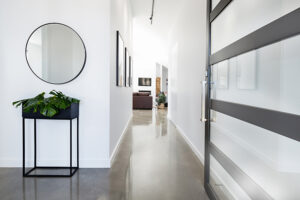Polished concrete is a flooring option that offers a variety of benefits and aesthetic options. It can be used in many applications, including residential and commercial projects.

When polished correctly, concrete floors become dust-free, resulting in a cleaner environment. They can also increase safety by reducing the amount of airborne particles that escape into the building. Read on to learn more.
Polished concrete is a type of floor that is popular in many homes and commercial buildings. It offers several benefits over other floor surfaces, including durability, cost, and aesthetics.
It is a great alternative to carpet, wood, tile, and other traditional flooring materials. Unlike most of these floor coverings, polished concrete is low-maintenance and never requires stripping or waxing. It also is less susceptible to stains, dents, or scratches.
In addition to its attractive appearance, polished concrete is also highly durable and can withstand heavy traffic, making it an excellent choice for industrial facilities. Moreover, it has the added benefit of being VOC-free, which makes it a better option for LEED projects.
Depending on the diamond grit used to polish concrete, floors can range from matte to a glassy mirror-like finish. Ultimately, what you choose to polish your concrete floors depends on your personal preferences and the style of your home or business.
The process of polishing concrete is similar to sanding wood, except that instead of using sandpaper, concrete polishing machines use disks made of diamonds to achieve varying levels of shine and smoothness. These machines are typically powered by heavy-duty motors, which grind the concrete’s surface to a degree of shine and smoothness that is comparable to polished granite or marble.
There are four different grades of polish available, from a matte to a high-gloss finish. The grit used can determine the level of sheen your floor will have, and you can even choose to add dyes during the polishing process for a more dramatic effect.
A polished concrete floor is an ideal way to increase the value of your home, and make it more appealing to potential buyers. Besides its attractive, timeless look, it can reduce energy costs by reflecting light and improving indoor ambient lighting.
It is also an excellent choice for commercial spaces, including grocery stores, restaurants, and other businesses. Its clean, attractive surface can improve customer satisfaction and employee morale in an office building or retail shop.
If you are interested in installing a polished concrete floor, it is important to find an experienced contractor who can deliver the best results for your project. A good contractor will have a thorough understanding of the various grits that should be used in the concrete polishing process, and they will be able to take the necessary precautions for a successful outcome.
Polished concrete is a popular choice for commercial projects like offices, factories, warehouses, and retail shops. It’s also becoming increasingly popular for residential spaces because of its beauty and durability.
Aesthetics is the field of philosophy that studies beauty, taste, and art. It also examines affective domain responses to things and events. Specifically, aesthetics seeks to understand the way people experience and appreciate art works, their ability to judge them, and how they perceive other people’s judgments of the works.
The field of aesthetics has been around for centuries, and is based on the idea that human perceptions are formed by experiences with the natural world and through interaction with other humans. The most common form of aesthetic experience is the enjoyment or appreciation of a work of art.
Many people associate polished concrete with a rough, industrial look, but that’s not the case anymore. As an alternative to natural stone, polished concrete offers a clean, modern appeal for any space.
It’s also an eco-friendly option that helps you attain points toward LEED project certification. It doesn’t require hazardous coatings, cleaners, or adhesives to maintain, and it’s free of dust, dirt, and allergens.
As a result, it can be easily installed and maintained. Plus, it can even be designed to mimic various materials, such as ceramic tile.